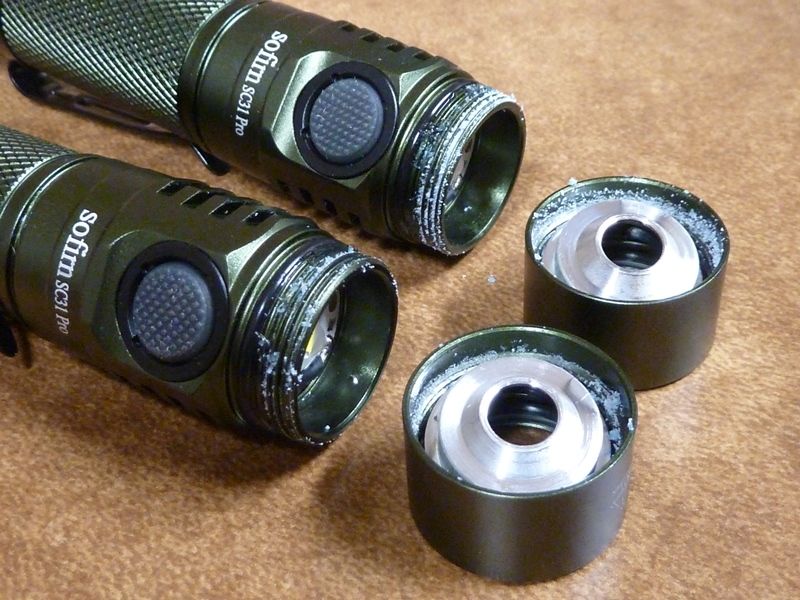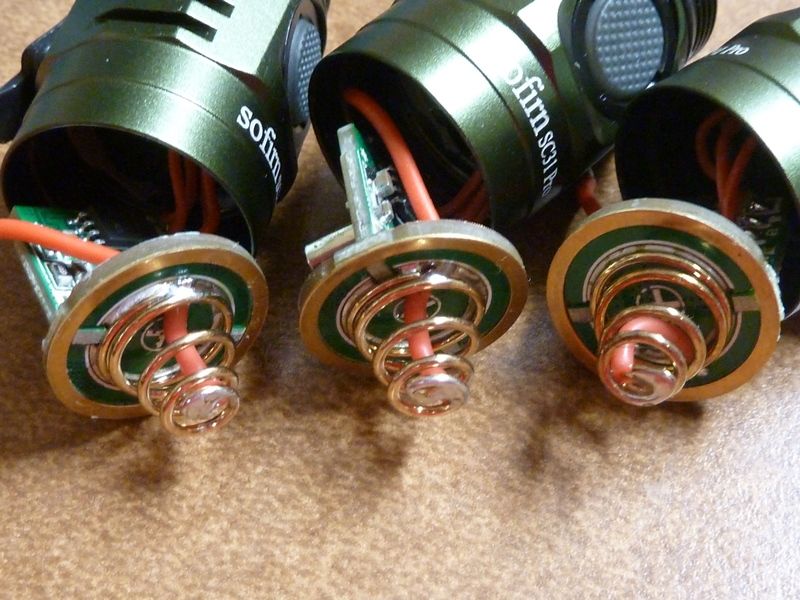I'm not sure exactly how the battery level works on a Fenix, but it's do-able. I think the 25-50-75-100 level detection is in Anduril 2, just not enabled, and doubt it would blink it out at turn on, but could be programmed to do so. It's a worth while feature to consider, for sure.
Its pretty simple, as soon as the light is turned on, the aux light simply goes solid green for over 75, blinking green for 50-75, solid red for 25-50 and blinking red for under 25.
all you need is a maybe add a 3 second timer to get your finger off the light to look. it really removes battery charge worries. having it buried in a sub menu i feel is not a great place.
is there a way to @ToyKeeper. To see what he/she says?
For those who don’t want it, could simply have a toggle behind the battery mode.
Does that mean 50% would range between 26% and 74%. Seems pretty broad if that is the case.
no. i gave the range above. 25-50 and 50 –75 would be different light groups
Ok, 25% range, Still broad . Why wouldn’t you want to know exactly. Anduril counts it out slowly enough. Now Convoy’s is hard to count it is so fast.
Ahh, ok - this SC31 Pro light has only one colored LED wired to the processor (MCU), not two. TK occasionally checks threads, bit the Anduril 2 thread may be the best for this, but she doesn't design or mod hardware.
because to me its useless. I don’t care if the voltage is 3.8 or 3.7, literally means nothing to me. I need to know if the battery needs to be charge, or roughly my runtime. 4 groups is all i need. over 75 % no charge, under 50, short or long walk depends on if charging. and if walking and really using a lot of lumens do i need to cut back etc.
my wife does not need to know the voltage range of a li-ion cell. not sure why anyone does. a voltage check now takes a bunch of clicks and counting, at least 20 seconds. this should take less than 3.
don’t use it, thats why i said toggle it. I don’t like carrying extra cells, i check voltages hourly sometimes with my fenix’s very simple.
has a red/ green light depending on charging. not looking to mod the lights, is it just a voltage change to go from red to green? I don’t really care how its done. it can be 4 blinks for all i care.
I will give this a couple days, then bounce the question over there. I am seeing “2” has aux light voltage check, so it appears this has already been thought about.
Thanks Tom
You can use a build option, in theory, to blink out a simpler battery level. This is the code in Anduril 2:
ifdef BATTCHECK_4bars
PROGMEM const uint8_t voltage_blinks[] = {
// 0 blinks for less than 1%
ADC_0p, // 1 blink for 1%-25%
ADC_25p, // 2 blinks for 25%-50%
ADC_50p, // 3 blinks for 50%-75%
ADC_75p, // 4 blinks for 75%-100%
ADC_100p, // 5 blinks for >100%
255, // Ceiling, don't remove (6 blinks means "error")
};
#endif // BATTCHECK_4bars
In theory, you can use this method instead of the big n.n method, just a compile setting.
you are significantly well versed in her code structure. it would take me a bit to learn and rewrite. I guess in “2” she did exactly what i asked with the 4 groups. I will be ordering a flashing kit over the next month
since you mentioned it only has 1 wire to the mcu, how are they accomplishing the green/red aux led indication?
Actually the 4 level batt level indicator stuff has been around a long time, I just wanted to verify it still exists in the latest A2.
Actually I was wrong - that specific code is not used on the A2 project, but there is a compiler setting: BATTCHECK_4bars, that should be used properly in the module: fsm-adc.c, just that it's untested, unproven, least as far as I know...
Green/red aux? You mean for battery charging? The MCU is not involved in the charging circuit -- totally separate controller. In theory, there is a spare pin, #7, than can be used for a 2nd AUX LED, but again, a hardware mod would be needed.
Maybe Wurkkos FC11 would be what you want if you can live without Anduril.
Didn’t realize the charge controller controlled the led separate, may i ask where you are seeing a diagram of the pinout wiring. I wrote over in the other thread to see if toykeeper is there. should be a simple build 1-4 blinks is all i need, i was just trying to be fancy with the different colors. no big deal if all green.
MCU pinouts on the SC31 Pro matches the Q8 w/AUX LED which matches the Emisar D4 (no AUX LED):
/* Emisar D4 driver layout
* ----
* Reset - |1 8|- VCC
* eswitch -|2 7|-
* AUX LED -|3 6|- PWM (FET)
* GND - |4 5|- PWM (1x7135)
* ----
*/
I reverse engineer the MCU pinouts, then try to identify the charging circuit controller, then find the datasheet on it.
FWIW, I am thankful for the voltage check on my SC31 Pro. A2 appears to reduce the number of clicks to get to it, on my TS21 anyway.
Like the idea of just having it flash out after a short delay on start up as well. I like the current setup much better than any of the lights I have where the button changes color on low voltage.
I can not imagine a use scenario where I would need to know the voltage of the battery on an hourly basis. If I had that kind of scenario I too would like the switch to provide the info at start. The power switch is already a real time battery status indicator for the way I use the light. I keep the memory at top of regulation. Simple math roughly 10 hours of use. If the switch light is bright I know that I am burning the battery at a rate likely to be closer to 3-4 hours or less. Not too difficult to have a rough idea of how long I can use it. However, I rarely use the light for prolonged periods so every so often I check the voltage. If I am going somewhere away from home where I am likely to want the light available I just swap cells with a fresh one. Otherwise, I just use it and don’t worry about it in the least. When I do get around to checking the voltage, if it is 3.8 or less I swap cells.
with in light charging, I don’t track usage, why should I need to. I have run down 18650’s in a day easy, i switched to 21700 in my headlamps because of that. look at all the different math and calculations you do, its not needed, especially with a light that can be programmed. My fenix’s all now have this. It’s a great feature. my nitecore has the voltage level check, I never use it.
if people don’t want it, it can be programmed to be toggled off.
Did not consider the in light charging part of the equation. Kind of forget the light has it and actually had rubber cemented the port cover. I like to know how my cells are performing. Mostly have a 30Q in it and certainly I have burned through an 18650 in a day with it. That kind of usage is the simplest of all for me. Just swap cells. I can see why you like the light blinking. Probably a much better thing if you always have the same cell in the light and especially if you use on board charging. As my SC31 Pro is deployed, the % range would still require me to remember which cell was in it as 50% charged would be different by quite a large amount of run time depending on what cell is in the light. Same with the voltage check. 3.7 volts (50%) would be anywhere from roughly 1000 mAh to nearly 2000 mAh depending on the cell.
since i have gone to in light charging, I haven’t even spun the tailcaps on my fenix lights since i bought them, some have over 500 hours on them. For the price point of the cells, (i just ordered a 3500 unprotected for the sc31 for 4 bucks. I don’t care about the cells, I have never really had one go bad).
to each their own, thats what makes the anduril nice, they can be programmed any way you want. I just have to figure out a flashing kit for this one.
its weird, I primarily use head lamps, and the 18650 last about 4-5 hours at my usage level. I found once the headlamp stopped running, i would stop working vs changing the cell. Idk. something about being covered in grease and dirt etc, made me reluctant to do it for the most part. they get plugged in overnight, and are ready in the morning.
Discharge curves vary for different cells. Some hang at the higher end until almost spent, whereas others drop voltage more linearly. So I go by voltage vs “percentages”.
I prefer the Nitecore method, where upon powerup, it blinks out the voltage. Easy to do that vs just blink-blink.
To program a SC31 Pro, there's no kit I'm aware of - have to buy the parts. The bezels on mine were glued up tight - used a strap wrench with the light in a vise w/pine boards.
Then need to get access to the driver. I pushed them out from a LED wire hole, and the drivers are glued pretty good too:
I programmed 5 greens, 1 black w/Anduril 2, added bypasses on the springs.
.JPG)

